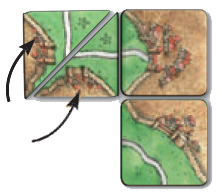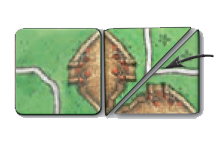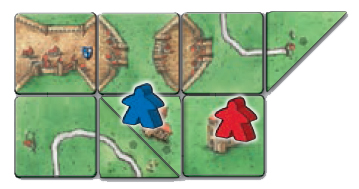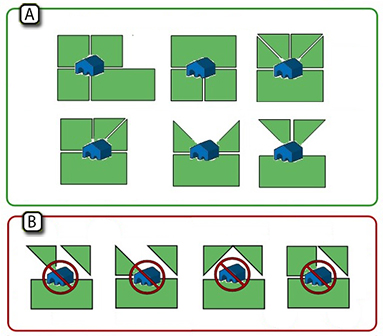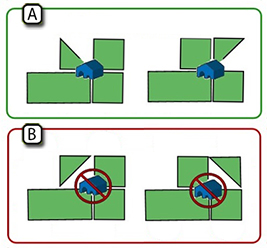Halflings (1st edition)
WikiCarpedia authors' disclaimer
Halflings designers took a gamble by changing the tile shape, which departs completely from the base game concept. We are far for judging whether this experiment was a success, yet we feel obliged to make a few statements.
All through WikiCarpedia we follow the facts and official clarifications but it is nearly impossible in the case of Halflings as it is unsupported by publisher. Due to its unique nature, it is even hard to work out a comprehensive set of rules that provides answers to all the open issues that may arise when interacting with other expansions.
In the end, please be warned that, while playing Halflings, you may come across situations that are not addressed here, not because we are not aware of those situations, but because we were not able to find answers within official clarifications. In such cases, feel justified to make house rules and have fun!
General info and comments
Halflings were originally released in Spielbox and Hans im Glück in 2014
The Halflings (or “Half & Half”) mini-expansion is available in two versions. One version is available in the 5/2014 issue of Spielbox magazine (www.spielboxshop.de) and these tiles are marked with the pentagon symbol. The second version was available at the Hans im Glück online shop (www.cundco.de) and these tiles are marked with the “C” Follower symbol. Therefore, it is possible that in the examples that follow, tiles may be shown that are not a part of the “Half” set you may own.
Contents
- 12 new “half-sized” triangular land tiles (Spielbox: Halflings I)
- 12 new “half-sized” triangular land tiles (Cundco: Halflings II)
Rules
Preparation
This mini-expansion is playable with up to 6 players. With additional copies, more than 6 may play. For the first game with this mini-expansion, we suggest mixing all triangular tiles face down, and giving 2 to each player. The players look at their tiles and return them face down to the table in front of them. Once the players are more familiar with the new tiles, they may want to try the following variant: At the beginning of the game all triangular tiles are placed face up on the table. A starting player is determined. Starting with the player who will be last in turn order and moving counterclockwise, everyone takes one tile and places it face down in front of him. All players then take a second tile in the same way. Thus, each player has chosen 2 tiles to use during the game. [1] [2] [3]
With the exception of the new rules used with this mini-expansion, all basic Carcassonne rules remain unchanged.
Placing a tile
On a player’s turn, he may play one of his 2 triangular tiles instead of drawing a normal tile. The triangular tiles are placed according to the usual rules; they must be placed so that at least one of the shorter sides of the tile touches a previously placed tile (not corner-to-corner only) or the longer side touches the longer side of another triangular tile.
In addition, any city, road, and field segments must continue segments already in play. Note: The longer side of a triangular tile may never be placed against the side of a normal tile.
Tiles with expansion features: Some of the tiles from the cundco.de version contain features from the Hills & Sheep and Crop Circles [4] [5] expansions. If you are not playing with those expansions along with “Halflings”, you may disregard those features.
Hills: If a player places a triangular tile containing a Hill feature, and you are playing with the Hills & Sheep expansion, he immediately draws a second (normal) tile, in accordance with the Hills & Sheep rules, and places it face down under the triangular tile. The other “half” of the face down tile may be covered with another triangular tile at a later time. Both triangular tiles would then be considered part of the same Hill.
Scoring
Note: After the original rules of 2014, the scoring rules for this expansion were changed in 10/2015.
- Original rules: a triangular tile scores as a normal landscape tile (1 point per tile). If there are 2 triangular tiles in the same square “space”, they still only count as 1 point (together) when scoring a feature: road, city or cloister.
- New rules: a triangular tile scores as a normal landscape tile (1 point per tile). If there are 2 triangular tiles in the same square “space”, they will count as 1 point each when scoring a feature: road, city or cloister.
The scoring rules next reflect the new ones.
Scoring a feature [6] [7]
Cloisters: When playing with “Halflings,” a cloister is considered to be completed even if one or more of its surrounding tiles are triangular tiles. In this case, a triangular tile scores as a normal landscape tile (1 point per tile surrounding the cloister.) If there are 2 triangular tiles in the same square “space”, they still only count as 1 point each for scoring a cloister. [8]
Final scoring
The game ends immediately at the end of the turn in which the last normal land tile is placed. If any player still has any unplayed triangular tiles in front of them, they may no longer play them. Final scoring then takes place.
Other expansions
- When a Halfling tile is beside a triangular gap, the Halfling tile counts as a single tile. When 2 Halfling tiles are side-by-side to create one square, together they count only as a single tile. This is relevant when considering cloister scoring, city scoring, road scoring, Dragon movement, the Plague token placement, the Flier movement, etc. (10/2014)
- A triangle tile takes the place of a regular landscape tile. Thus, a single triangle hole in the map does not stop the row or column for scoring for German and Dutch/Belgian Monasteries. Only a hole of a complete regular landscape tile interrupts the row or column. (3/2015)
- A single triangle hole does not prevent the Plague from spreading in that direction. (10/2015)
- An abbey can be placed if a Halfling tile is on one of the edges, even if there is a Halfling gap on one of the edges. See the clarification images below. (3/2015)
- A barn can be placed as long as 4 tiles touch at the intersection, even if there is one or more Halfling tiles. (10/2015)
- Additionally the barn placement rules have been updated as follows: The base ground for the barn has to be stable so it cannot wiggle. This means that under the barn:
• all tiles have to touch each other in the middle;
• no quarter is empty in the middle; and
• all tiles have farm in the middle for the placement of the barn.
See the following examples involving Halfling tiles and double-size tiles (see Castles in Germany.) (04/2016)
- The previous rules update overrides, in certain cases, the original four-tile intersection requirement for the placement of the barn defined originally for square tiles. This happens in favor of providing stability to the barn when tiles with other geometries are considered, as can be seen in the examples involving double-size tiles and/or triangle tiles.
There are no official clarifications about the interactions with several expansions regarding how to deal with triangle tiles and gaps in the following cases:
- The Princess and the Dragon: moving the dragon;
- The Tower: computing the tower range;
- The Flier: the flier distance and landing place;
- German/Dutch and Belgian Monasteries: scoring and abbot.
At present HiG does not support this expansion and no further clarifications will be provided. Combining Halflings these expansions will then happen "at the players' own risk." In such cases, house rules will have to be agreed/applied.
Tile distribution
Halfling I (Spielbox)
Total Tiles: 12 halves
Halfling II (Cundco)
Total Tiles: 12 halves
Footnotes
For Icons explanation and licensing please visit Icons page.
- ↑
 When playing with fewer than 6 players, each player should still only end up with 2 tiles. (3/2015)
When playing with fewer than 6 players, each player should still only end up with 2 tiles. (3/2015)
- ↑
 As an alternative, when playing with fewer than 6 players, each player could draw or choose tiles until the tiles are depleted and each player has the same number of tiles (e.g., 4 players get 3 each). (3/2015)
As an alternative, when playing with fewer than 6 players, each player could draw or choose tiles until the tiles are depleted and each player has the same number of tiles (e.g., 4 players get 3 each). (3/2015)
- ↑
 When playing with both Halflings I and II, there is no consensus regarding number of tiles per
person. They are technically two separate mini-expansions, so players could take 2 from each set.
Alternatively, because they have the same rules and are thus functionally one larger expansion,
players could take 2 Halfling tiles total. (3/2015)
When playing with both Halflings I and II, there is no consensus regarding number of tiles per
person. They are technically two separate mini-expansions, so players could take 2 from each set.
Alternatively, because they have the same rules and are thus functionally one larger expansion,
players could take 2 Halfling tiles total. (3/2015)
- ↑
 The sheep on the tile counts as a "permanent" sheep token every time that a shepherd on the associated field scores his sheep. (11/2014)
The sheep on the tile counts as a "permanent" sheep token every time that a shepherd on the associated field scores his sheep. (11/2014)
- ↑
 The circular crop circle on the Halfling tile is a Joker. This means that the player who places this tile can decide if he or she wants to treat it as a shield, a pitchfork, or a club. (11/2014)
The circular crop circle on the Halfling tile is a Joker. This means that the player who places this tile can decide if he or she wants to treat it as a shield, a pitchfork, or a club. (11/2014)
- ↑
 Additionally to the regular rules, a city is considered completed if it contains no triangular gaps in its interior or its walls. The scoring will follow the normal rules and any triangular tiles will be counted as a regular tile.
Additionally to the regular rules, a city is considered completed if it contains no triangular gaps in its interior or its walls. The scoring will follow the normal rules and any triangular tiles will be counted as a regular tile.
- ↑
 Additionally to the regular rules, a road is considered completed if it contains no triangular gaps. The scoring will follow the normal rules and any triangular tiles will be counted as a regular tile.
Additionally to the regular rules, a road is considered completed if it contains no triangular gaps. The scoring will follow the normal rules and any triangular tiles will be counted as a regular tile.
- ↑
 The following image show a scoring example of a completed cloister with Halfling tiles in its surroundings.
The following image show a scoring example of a completed cloister with Halfling tiles in its surroundings.



